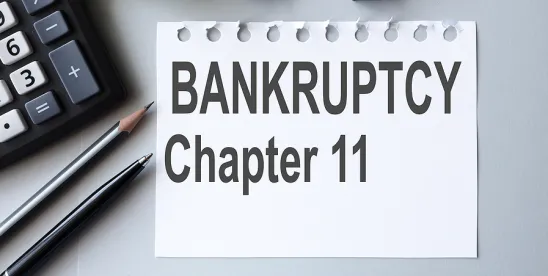Navigating a successful restructuring requires skill and experience to look around corners, anticipate issues, and take proactive steps to minimize risk and uncertainty. In this alert we highlight one of those risks — “insider” status in a chapter 11 case. When a lender is tagged with “insider” status, that designation can disrupt the restructuring flight path and is sometimes used by out-of-the-money stakeholders as a litigation tool to create negotiating leverage. We unpack the technical insider definition and the practical consequences that flow from insider status.
A. What Is an Insider?
“Insider” is defined in the Bankruptcy Code differently depending on the debtor’s corporate form. Because an overwhelming majority of private credit borrowers are corporations or limited liability companies (LLCs), we focus our discussion on those entities. An “insider” of a corporation and an LLC[1] is defined in section 101(31) of the Bankruptcy Code with a non-exclusive list of eight relationships with the debtor: (1) a director; (2) an officer; (3) a “person in control of the debtor;” (4) partnership in which the debtor is a general partner or a general partner of the debtor; (5) a relative of a general partner, director, officer or person in control of the debtor; (6) an “affiliate” of the debtor, which in turn is defined to include any entity that “directly or indirectly owns, controls or holds with power to vote, 20 percent or more of the outstanding voting securities of the debtor;”[2] (7) an insider of an affiliate as if such affiliate were the debtor; and (8) a managing agent of the debtor. Anyone who fits within this list is a “statutory insider.”
The list of statutory insiders is self-explanatory other than “person in control of the debtor.” Courts interpret this phrase to capture anyone with “actual control” over the borrower to “unqualifiably dictate corporate policy and the disposition of corporate assets” or the “legal right or ability to exercise control over a corporate entity.”[3] A “person in control of the debtor” must have authority similar to an officer, director or general partner to manage the debtor’s day-to-day operations.[4] To satisfy this standard, “there must be day-to-day control, rather than some monitoring or exertion of influence regarding financial transactions in which the creditor has a direct stake.”[5]
The Bankruptcy Code’s insider definition is illustrative, and, therefore, not exclusive. Consequently, courts have held that “insiders” also include “any person or entity whose relationship with the debtor is sufficiently close so as to subject the relationship to careful scrutiny.”[6] This type of insider is referred to as a “non-statutory insider.” Whether someone is a non-statutory insider is “determined on a case-by-case basis based on the totality of the circumstances, including the degree of an individual’s involvement in a debtor’s affairs.”[7]
The theme for both statutory and non-statutory insider status is the degree of control over the borrower.[8] What kind of control is sufficient to render a lender an insider? Given the highly‑factual nature of the inquiry, it depends on the context but generally involves the ability to direct corporate actions.
B. Consequences of Being an “Insider”
A lender that has been tagged with “insider” status can expect the following incremental risk exposure in a bankruptcy of the borrower:
- Heightened Scrutiny. Courts examine transactions with insiders with heightened scrutiny — generally under an “entire fairness” standard — as compared to the more deferential “business judgment” standard. For example, where an insider-lender provides postpetition DIP financing or credit bids for collateral in a 363 sale, the court will closely review the transaction terms and the process through which the debtor decided to enter the transaction with the insider-lender.
- Preference Risk. Section 547 of the Bankruptcy Code provides the ability to avoid transfers made by the debtor to a creditor on account of existing debt. The reach-back period is 90 days before the filing of the bankruptcy unless the transferee is an insider, in which case the reach-back period is extended to one year. Thus, pre-filing payments to insiders are at greater risk of preference claw-back.
- Fraudulent Transfer Risk. Section 548 of the Bankruptcy Code and state law provide the ability to avoid transfers made or obligations incurred either (i) with actual intent to hinder, delay or defraud creditors, or (ii) while insolvent or undercapitalized in exchange for less than reasonably equivalent value. For actual fraudulent transfers, courts typically look at so-called “badges of fraud,” which include transfers made to or the benefit of insiders. Thus, pre-filing transactions with insiders are subject to, at a minimum, greater scrutiny for avoidance as a fraudulent transfer.
- Equitable Subordination Risk. Section 510(c) of the Bankruptcy Code recognizes the common law remedy of equitable subordination, which permits the court to subordinate a claim to another claim as a remedy for creditor misconduct. Equitable subordination is an extraordinary remedy and requires a showing that (i) the lender engaged in some type of inequitable conduct, (ii) the misconduct injured a creditor of the debtor or conferred an unfair advantage to the lender, and (iii) equitable subordination will not conflict with other provisions of the Bankruptcy Code. Courts will review an insider’s actions with rigorous scrutiny, and less egregious conduct (as compared to non-insiders) may support a claim for equitable subordination. Inequitable conduct includes (i) fraud, illegality and breach of fiduciary duties, (ii) undercapitalization of the debtor, and (iii) the creditor’s use of the debtor as an alter ego.
- Recharacterization Risk. Recharacterization is a remedy which allows a court to treat debt as if it were equity and is most often applied to insider loan transactions that are disguised equity contributions. Thus, when a lender is tagged as an insider, the insider-lender’s loan will be more susceptible to recharacterization risk.
- Plan Voting. Confirmation of a chapter 11 plan requires, among other things, the acceptance of at least one impaired class of creditors. For purposes of determining whether an impaired class has accepted the plan, section 1129(a)(10) of the Bankruptcy Code provides that insider votes are disregarded. This means that if a lender is an insider, its vote will be disregarded for determining compliance with section 1129(a)(10).
C. Recommendations
Here are some 10 tips to mitigate lender liability and the risk of being tagged with “insider” status:
- In any restructuring, a lender will not know from the onset of the borrower’s distress whether it has a situation that will be resolved consensually or whether it will be heavily litigious. Thus, prepare for the worst and hope for the best.
- Act like a lender and not an owner. Do not control the borrower. Lenders do not determine whom to hire or fire, or whom to pay. That does not mean a lender cannot impose discipline after a default where funding is discretionary pursuant to an agreed-upon budget, or otherwise insist on conditions for an amendment, waiver or forbearance (g., commencement of sale process, retention of investment banker, or appointment a chief restructuring officer).
- Make recommendations as opposed to directives.
- Consider downshifting lender-affiliated directors to observers and hardwiring a requirement to share board packages with lenders in the forbearance agreement.
- When appointing independent directors in stressed circumstances, avoid appointing lender-affiliated directors. Recognize that all material connections will be explored (and potentially exploited) to evaluate (or create noise) about undue control or bias.
- Avoid excessive internal and external emails — especially those with overheated rhetoric. Assume every email will be read by the court. When in doubt, do not say it or send it.
- Assume communications may be distorted and twisted to fit an adversary’s narrative.
- Recognize that a settlement discussion (often with the protection of Rule 408 of the Federal Rules of Evidence) is not blanket immunity.
- Include counsel and avoid internal email discussion. That said, not every communication with counsel will be protected from disclosure — generally only communications seeking legal advice are protected.
- Be prepared. Litigation is a tool for out-of-the-money constituents to use to create value by being obstructionist. There is a significant difference between a “material risk” of liability and the risk of being sued.
____________________________________________
[1] Courts have held that a corporation under the definition of “insider” includes LLCs. See In re Brooke Corp., 506 B.R. 560, 566-67 (Bankr. D. Kan. 2014); In re Longview Aluminum, LLC, 657 F.3d 507, 509 n.1 (7th Cir. 2011).
[2] 11 U.S.C. § 101(2).
[3] In re U.S. Med., Inc., 531 F.3d 1272, 1277 n.5, 1279 (10th Cir. 2008) (internal quotations and citations omitted); In re Winstar Commc’ns., Inc., 544 F.3d 382, 396 (3d Cir. 2009).
[4] See Winstar, 544 F.3d at 395-96 n.5 (“There must be day-to-day control, rather than some monitoring or exertion of influence regarding financial transactions in which the creditor has a direct stake.” (citing In re Winstar Commc’ns, Inc., 348 B.R. 234, 279 (Bankr. D. Del. 2005)).
[5] Id.
[6] Hunter v. Babcock (In re Babcock Dairy Co. of Ohio, Inc.), 70 B.R. 657, 660 (Bankr. N.D. Ohio 1986); see also Matter of Krehl, 86 F.3d 737, 741 (7th Cir. 1996) (noting the definition of “insider” is “intended to be illustrative rather than exhaustive”); Winstar, 554 F.3d at 395.
[7] In re Borders Grp. Inc., 453 B.R. 459, 469 (Bankr. S.D.N.Y. 2011). Some courts apply a two-prong test that looks at whether (i) there is a close relationship between the debtor and creditor, and (ii) the transactions between them were conducted at arm’s length. In re RayTrans Holdings, Inc., 573 B.R. 121, 132 (Bankr. D. Del. 2017) (citing U.S. v. State St. Bank & Trust Co., 520 B.R. 29, 81 (Bankr. D. Del. 2014)).
[8] However, some courts may look to factors outside of control to determine insider status. See In re Vill. at Lakeridge, LLC, 814 F.3d 993, 1001 (9th Cir. 2016) (“[S]ome degree of control is one of many indications that a creditor may be a non-statutory insider, but actual control is not required to find non-statutory insider status. . . . Likewise, access to the debtor’s inside information may — but not shall — warrant a finding of non-statutory insider status.” (citations omitted)).




 />i
/>i
